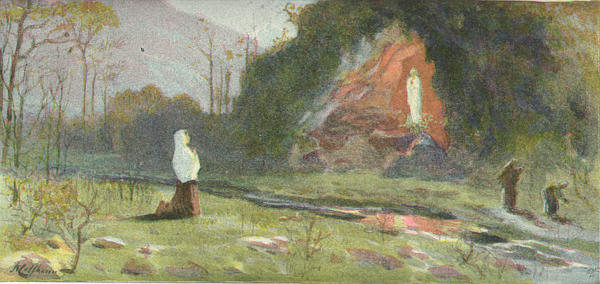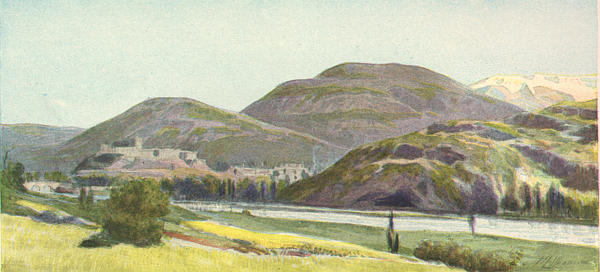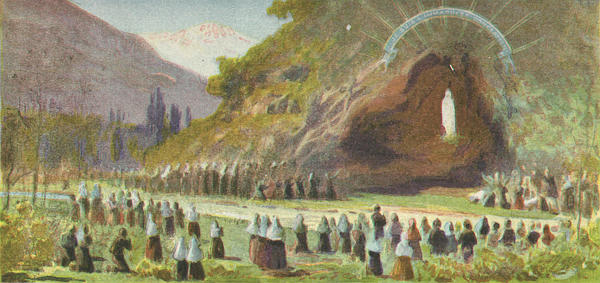
Notre Dame's Grotto / by Dorothy V. Corson


The Song of Bernadette Movie
Hollywood made a beautiful inspirational movie about the Lourdes Grotto in France during the second World War. It premiered in 1943. The book it was based on was written by a Jewish man, Franz Werfel, who escaped from the Germans and found shelter in Lourdes. He vowed that if he escaped the war alive he would sing the song of Bernadette. He kept that vow and her story was published in 1942. From the book, a screenplay was written with the same name: The Song of Bernadette. It was an event that would add its own dimension to the story behind the Notre Dame Grotto.
A book entitled:The Glories of the Catholic Church in Art, Architecture and History by Maurice Francis Egan and St. Bernadette, a pictorial book on the Lourdes Grotto in France, written by Leonard Von Matt,(233) covered the beautiful countryside and the site of the Grotto. Von Matt's book had a number of pictures of Bernadette at the time she first saw the apparitions. It also had a close-up photograph of the Our Lady of Lourdes statue in the Grotto in France. When it was compared with the photographs taken of the replica of the statue in Lourdes Hall at Saint Mary's, it showed it to be the same size and likeness done by the original artist, just as it was described by Mother Angela in 1873. Both Mother Angela and Father Sorin must have brought back from Paris an exact copy of the Our Lady of Lourdes statue done by the same sculptor. Discovering Leonard Von Matt's lovely illustrated book about St. Bernadette, Lourdes, and the surrounding countryside, was the next best thing to being there.
The first book was written by Maurice Francis Egan who was brought to Notre Dame from New York by Fr. Walsh to chair the Literature Department. He lived adjacent to the campus on Notre Dame Avenue in a home built for him by the university. Egan loved lilacs. He wrote to all his friends asking them to send him different varieties of the bush to make a hedge around his home. He then christened it, "The Lilacs," a name it still retains today.
It is worthy of note that Maurice Francis Egan's impressive book, The Glories of the Catholic Church in Art, Architecture and History was published in 1895, a year before the Notre Dame Grotto was built on campus. Notre Dame University was included but not Sorin's 1878 Grotto. In 1895 the 1896 Grotto was still a dream in Fr. Corby's heart at the time. It became a reality the following year.
In it, Egan explained why he wrote the book in which he describes and pictures famous churches and shrines all over the world. He said he felt that many people could not afford to travel to these places to see them in person and the next best thing might be a book picturing and describing these famous churches and shrines. One of the churches and shrines he depicted was the Church of the Holy Rosary and the Grotto of the Holy Virgin at Lourdes. It begins with his description of this world-famous shrine.

Grotto of the Holy Virgin -- Lourdes. Lourdes is a small village in the south of France, at the common entrance to several deep gorges of the Pyrenees. Near the town is an almost perpendicular cliff known as Massabielle, which means, in the dialect of the country, 'The Old Rocks." In this cliff is a natural grotto about twelve feet high and twelve feet deep, within which is a sort of niche about six feet high, of almost oval shape. It was in this niche that on the 11th of February, 1858, the Virgin Mother of God appeared to the little shepherdess, Bernadette Soubirous, who was gathering sticks along the banks of the neighboring stream. Her form, full of divinest grace, 'was surrounded with an aureole of inconceivable brightness, not like the piercing light of the sun, but rather like a bundle of rays softened by a gentle shade, which irresistibly attracted the gaze, and on which the eyes reposed with ecstatic delight.' She held a chaplet, whose milk-white beads were gliding one by one through her fingers, while she seemed to be listening to the recitation of the rosary throughout the world. Again and again Bernadette went to the spot accompanied at first by a few of her child companions, and afterwards by crowds of people, and each time beheld the same gracious vision, at the sight of which her person was so transfigured that her every movement and gesture had a nobleness and dignity that seemed to onlookers more than human. The glorious apparition sometimes spoke to her, and once, after imparting to her a secret of personal import, regarding which she required secrecy, she commanded her to tell the priests that she wished a chapel built there in her honor. The celestial visitations still continued for a time; a copious spring of water burst forth in the cave at the Virgin's command, though it had always before been perfectly dry, and Bernadette was commanded to drink of the water and to bathe herself with it. At last, on the feast of the Annunciation, in response to a request made by Bernadette on an earlier occasion, that she should reveal in unmistakable terms her identity, the fair Vision raised her arms toward heaven, with the words, 'I am the Immaculate Conception." Thus did the definition of the apostolic doctrine of the perfect and perpetual purity of the Mother of God receive a special confirmation from her own sweet lips, and prepare the way for the rich outpouring of Divine favors which soon followed.

For the fervor with which the villagers received this celestial manifestation soon communicated itself to all parts of the Christian world. A great basilica was built at an enormous cost above the grotto, and other buildings were put up one after another until the whole city has arisen around the sacred spring, whose waters have flowed throughout the world, their channels marked by miracles of bodily and spiritual healing. Shrines in honor of Our Lady of Lourdes have sprung up even in the most distant places, and the wonders worked by Our Lady's intercession under this title have everywhere confuted the enemies of the supernatural.
In the spot where the Blessed Virgin appeared stands a life-size statue conforming to the description given by Bernadette, and at its base still grows the wild rose which the feet of the Holy Virgin touched. The upper church of the basilica is lined with the silken banners of various nations and confraternities and guilds, which have been hung there by visiting pilgrims. . . .
His detailed description of this world-famous church and shrine follows.